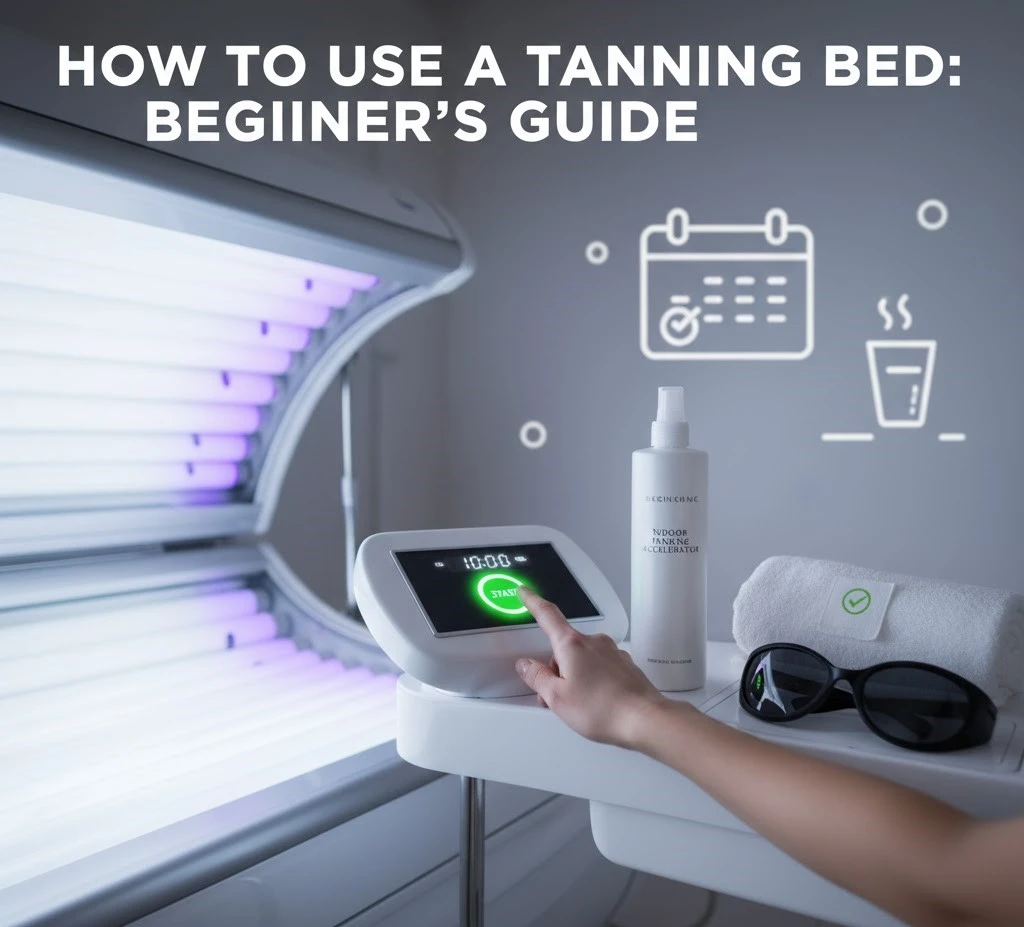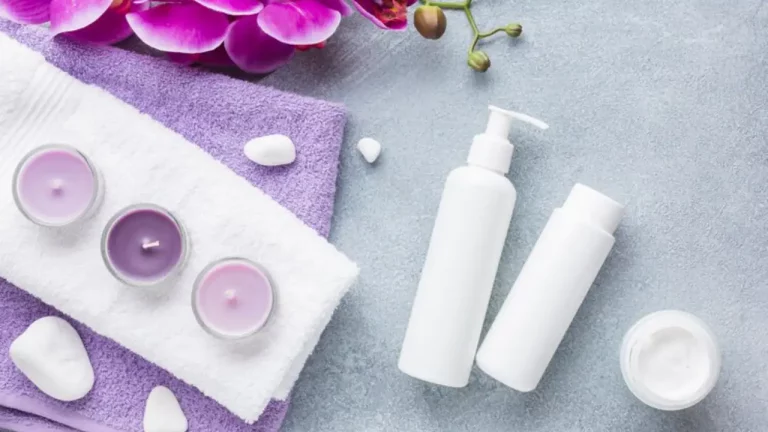Tanning Bed Tips for Beginners to Tan Safely
Using a tanning bed can appeal if you want a quick glow or even tan outside of sunny weather. But “quick glow” comes with real risks. Scientific evidence shows that indoor tanning devices pose serious health hazards.
This article gives you an in-depth, beginner-friendly guide on how to use a tanning bed safely — how they work, how you prepare your skin, how to tan step-by-step, and how to avoid common mistakes. We focus on real, accurate facts from trusted sources. Use these “Tanning Bed Tips for Beginners” to make better decisions.
Table of Contents
Why People Use Tanning Beds
People choose tanning beds for several reasons. Understanding those helps you decide if it’s right for you.
Convenience
- Tanning beds work anytime, indoors, regardless of weather.
- You control the session start, avoid unpredictable daylight or weather changes.
- Salon setups often allow intervals of use when outdoor sun-time is limited.
Even Tan
- Many users believe indoor tanning gives a more uniform tan because the light comes from above and around you in a controlled space.
- In contrast, outdoor tanning depends on sun angle, clouds, and other factors.
Appearance Boost
- A tan often makes skin look darker, which some people prefer for aesthetic reasons.
- Some think a tan hides skin imperfections or gives a “healthier” look.
- These motives drive the use of tanning beds despite risks.
Vitamin D and Mood (Perceived)
The health benefit claim is weak and does not offset the risks.
Some people believe tanning beds help with vitamin D production or mood.
But most tanning beds emit primarily UVA light. UVA does not trigger vitamin D production the way UVB does.
How Tanning Beds Work
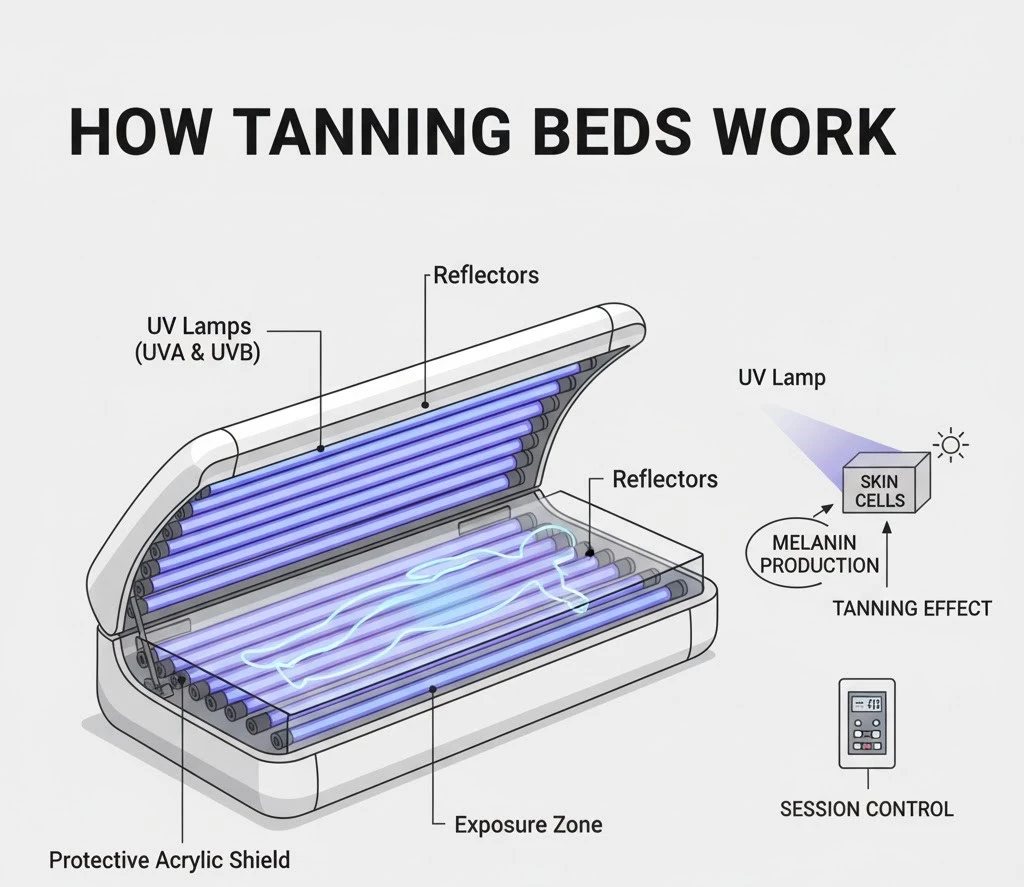
Understanding how indoor tanning works helps you understand both how the tan happens and how the damage happens.
- A tanning bed uses ultraviolet (UV) light from special lamps. It mimics sunlight but in a concentrated way.
- These devices usually emit mostly UVA rays, with smaller amounts of UVB.
- UVA rays penetrate deeper into the skin, cause immediate pigment darkening, and contribute to long‐term skin damage.
- UVB rays are the ones more responsible for sunburn and stimulate melanin production (which leads to a deeper tan over time) though many tanning beds reduce UVB output purposely.
- When your skin is exposed to UV rays, it responds by darkening pigment (melanin) and thickening slightly as a defense. That darkening is what you call a “tan”. But it is also a sign of skin cell damage.
Why indoor tanning can be more intense
- Because of this intensity, the risks can accumulate faster than outdoor sun exposure.
- Some tanning beds emit UVA at levels higher than midday sun.
Safety Importance for Beginners
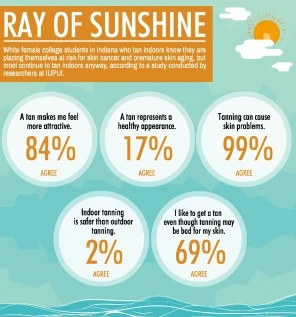
Before jumping into a tanning bed session, it’s vital you know the safety landscape.
- According to American Academy of Dermatology (AAD), using indoor tanning devices increases your risk of squamous cell carcinoma by 58% and basal cell carcinoma by 24%.
- If you use a tanning bed before age 35, your risk of developing the deadliest form of skin cancer (melanoma) increases by up to 75%.
- The Food & Drug Administration (FDA) classifies tanning devices as “moderate risk” and mandates warning labels about skin cancer, eye injury and burns.
- A tan is not a sign of healthy skin. The skin is reacting to damage.
Bottom line for beginners: If you use a tanning bed, you must treat it like a procedure that carries real risk. Moderation, protection and mindful preparation matter
Preparing Your Skin Before Using a Tanning Bed
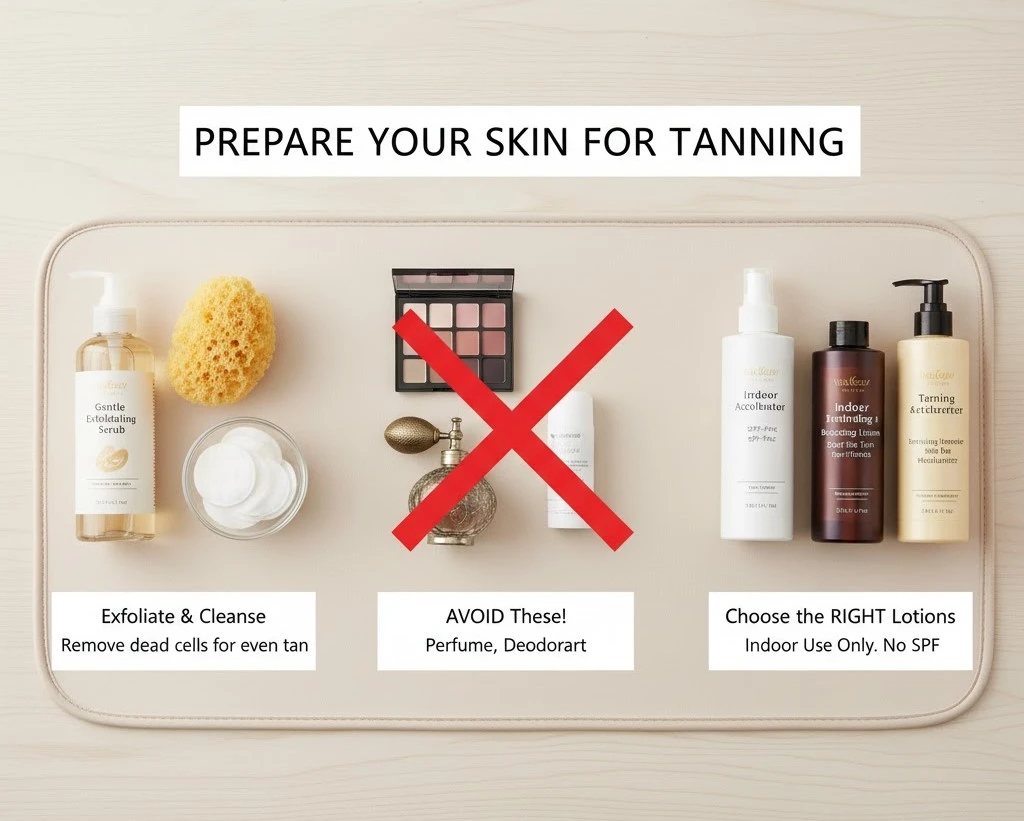
Exfoliate and Cleanse Your Skin
- Remove dead skin cells to help your tan develop evenly.
- Use a gentle exfoliator the day before you plan to tan.
- Cleanse your skin thoroughly to remove sweat, dirt or residues that might block UV exposure in spots.
- Avoid heavy scrubs immediately before tanning; too aggressive exfoliation can make your skin more sensitive to UV.
Avoid Makeup, Perfume, and Deodorants
- Makeup often contains minerals or pigments that can block or unevenly reflect UV light.
- Perfume, deodorants, and fragrance products may contain compounds that react under UV radiation and can cause irritation or uneven tan.
- Always tan with clean, bare skin, free of cosmetic layers.
Choose the Right Tanning Lotion
- Use lotions formulated for indoor tanning (not outdoor sun lotions). These are designed to support the indoor UV spectrum and are typically free of SPF (since SPF would block the tan).
- There are indoor tanners, bronzing accelerators, and moisturizers. Choose one that matches your goal (e.g., deeper tan vs. maintenance) and your skin type.
- Keep in mind: using any lotion does not remove the UV risk. The preparation only helps your skin respond more evenly.
How to Use a Tanning Bed Step-by-Step
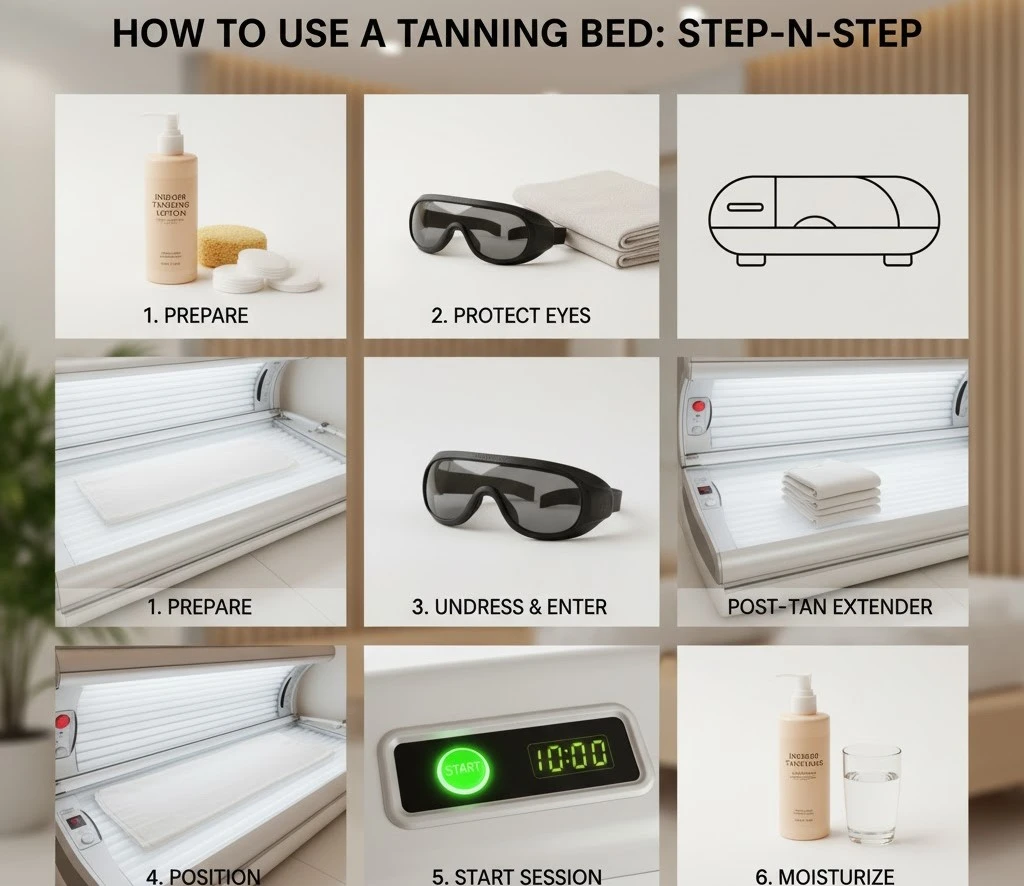
Understand Your Skin Type
| Skin Type | Typical Features | Recommended Approach |
|---|---|---|
| Fair (Type I-II) | Always burns, seldom tans | Start with very short exposures (e.g., 5 min or less) |
| Medium (Type III-IV) | Burns sometimes, tans gradually | Moderate exposures (6-8 min) depending on machine |
| Darker (Type V-VI) | Rarely burns, tans easily | Longer exposures may be possible, but caution still required |
- Tanning bed exposure times must be adjusted for your skin type.
- If you have fair skin or a history of burns, be particularly cautious.
- Even darker skin doesn’t mean you’re immune from UV damage.
Start Slow and Short
- On your first session, limit your time. For example, 5–7 minutes or as the salon recommends.
- Resist the temptation to jump to maximum time. Overdoing it leads to burns or peeling.
- Allow your skin to build tolerance gradually.
Adjust Position and Timing Gradually
- Flip halfway through the session (if the bed is designed for it) so your front and back get even exposure.
- Keep your body flat and the same distance from the bulbs on both sides if lying down.
- After a few sessions without redness or issues, you can slowly increase time by 1-2 minutes per session, always staying within salon or machine guidelines.
- Track your skin’s response: redness, irritation or unusual tanning patterns mean you should cut back.
Safety Tips During Tanning Bed Sessions
Always Wear Eye Protection
- The eyes are very sensitive to UV. The American Academy of Ophthalmology states that tanning beds can produce UV levels up to 100 times what you’d get from the sun, which can damage your cornea, lens or retina. Aftercare Tips for Post-Tanning Bed Sessions
- Moisturize Generously
- Immediately after your session apply a fragrance-free, gentle moisturizer or aloe-vera based lotion.
- This helps soothe the skin and lock in the color.
- Avoid heavy perfumed creams right after UV exposure; they may irritate sensitive skin.
- Avoid Showering Immediately
- If possible, wait 4-6 hours (or as recommended by the salon) before your first wash. This gives your tan time to settle in.
- When you do shower, use lukewarm water and avoid harsh soaps which may strip your tan prematurely.
- Maintain Skin Health Between Sessions
- Use a broad-spectrum sunscreen with at least SPF 30 every day — even when indoors — to protect skin from incidental UV exposure.
- Exfoliate gently once or twice a week (but not the day of or day after tanning) to remove dead skin cells and help prolong your tan.
- Limit tanning sessions to recommended frequency (see next section) to avoid cumulative damage.
- Use FDA-approved tanning goggles. Don’t use sunglasses or ordinary glasses.
- Make sure the goggles fit snugly and block all stray light.
- Avoid looking at or near the bulbs.
Stay Hydrated and Keep Skin Moisturized
- UV exposure dehydrates the skin. Drink water before and after your session.
- Use a moisturizer designed for post-tanning to keep skin supple and reduce peeling.
- Well-moisturized skin will help maintain the tan longer and feel healthier.
Avoid Overexposure and Burning
- If your skin turns red or you feel burning after a session, stop.
- Signs of over-tanning: redness, itchiness, peeling, heat on the skin.
- Give your skin rest days between sessions. Never back-to-back days when you are a beginner.
Common Mistakes Beginners Should Avoid
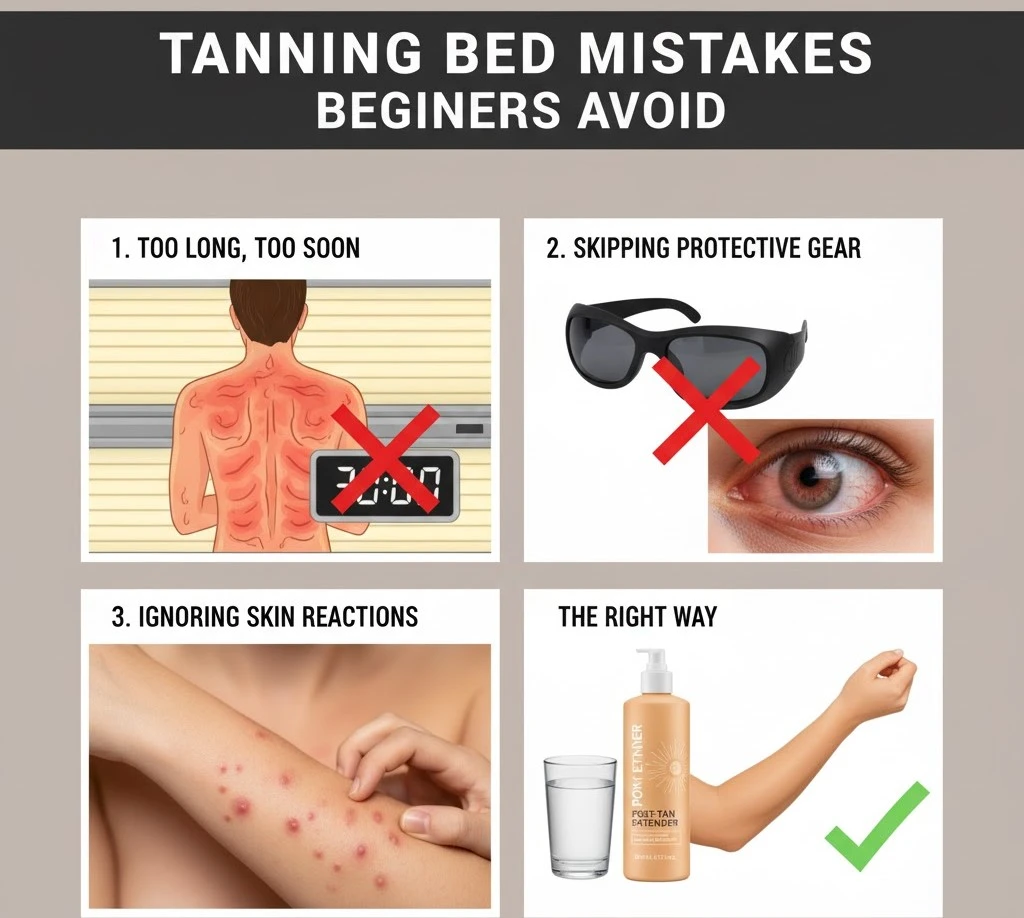
Tanning Too Long Too Soon
- Rushing to get a deep tan on the first few sessions increases your risk of burns and peeling.
- Respect your skin’s adjustment period.
- A gradual build-up is safer and gives more sustainable results.
Skipping Protective Gear
- Not wearing proper goggles is risky.
- Ignoring lip protection, or not applying lip balm at all, exposes lips to UV damage.
- Using makeup or perfumes in the bed can interfere with the tan and cause uneven skin reactions.
Ignoring Skin Reactions
- If you develop redness, itchiness, blistering, or unexpected rash, stop immediately and consult a professional.
- Even without obvious problems, pay attention to the overall response of your skin.
- If you notice moles changing, or new spots appearing, see a dermatologist.
Expert Tips to Enhance Your Indoor Tanning Results
Use a Quality Indoor Tanning Lotion or Accelerator
- Specialty indoor tanning lotions often contain ingredients that support melanin production or protect skin from dryness.
- Accelerators may help deepen your tan safely when used correctly.
- Ask for salon-approved products and follow instructions.
Maintain a Consistent Schedule
- For beginners, limit to 2-3 sessions per week at most until you establish how your skin reacts. Excessive frequency increases risks.
- Many experts recommend stepping down after you reach your ideal shade to maintenance mode (once a week or every two weeks) instead of continuous exposure.
Combine Indoor and Outdoor Care
- If you go outside, always protect your indoor tan with broad-spectrum sunscreen and protective clothing.
- Avoid natural sun exposure immediately after tanning sessions; your skin is more vulnerable.
- Use outdoor shade, hats and sunglasses to preserve your skin health and extend the life of your indoor tan.
Conclusion
Using a tanning bed can give you a quick bronze look, but it comes with serious risks. If you decide to proceed, you must do so with full awareness, preparation and protection. Use the “Tanning Bed Tips for Beginners” above to guide each step: skin prep, short exposure, protective gear, hydration, and aftercare.
Always remember: your skin is reacting to UV damage when you tan. Every session carries risk. Early, careful use may reduce immediate danger, but the long-term risk remains significant. Choose wisely, act deliberately, protect your skin, and always prioritise safety over speed or shade.
FAQ’s
1 How often should beginners use tanning beds?
As a beginner, limit yourself to 2-3 sessions per week at first. Watch your skin’s response. Avoid daily sessions.
2 What is the safest tanning bed time for fair skin?
For fair skin (that burns easily), start with 5-7 minutes. Stay at that time until you know how your skin handles it, then slowly increase only if recommended.
3 Can I wear sunscreen in a tanning bed?
Using sunscreen does not make tanning beds safe. Even with sunscreen you still receive intense UV exposure. The goal of indoor tanning is to get pigment change, and SPF reduces that. Major health organisations discourage sunscreen use as a justification for tanning bed exposure.

